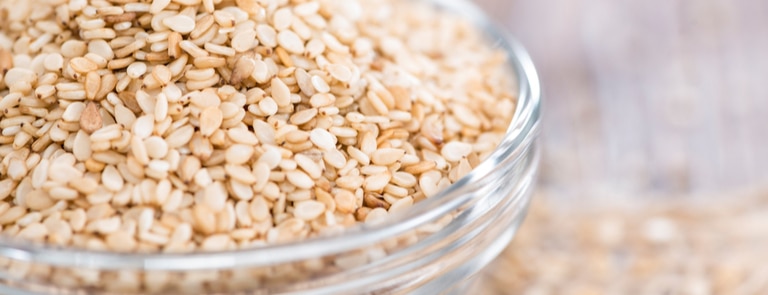10% off £35
Sesame benefits

These tiny, oil-packed seeds are used in numerous different cuisines and have a truly unique taste. Wondering how sesame seeds can benefit your entire body and not just your tastebuds? Let’s take a look…
First things first, what is sesame?
Sesame is a crop grown in tropical and subtropical regions, including Asia, South America, and Africa. It’s mostly cultivated for its seeds which are rich in oil and packed with nutrients.1
You can eat sesame in various ways, from adding whole seeds to dishes to using sesame oil in dressings and sauces. It’s also the main ingredient in tahini – a type of paste used in Middle Eastern and Mediterranean cuisine to create dishes like hummus and baba ghanoush.
Benefits of sesame
As well as having a unique taste, sesame has been used for hundreds of years as folk medicine. Among these small yet mighty seeds’ benefits include the fact they2:
-
Are a natural source of protein
Sesame is a good plant protein source, with 30g of seeds estimated to contain 5g of protein.
-
Contain fibre
Sesame seeds contain a fair amount of fibre, a substance needed by the body to support healthy digestion
-
Are rich in B vitamins
In addition to other vitamins, sesame is rich in a range of B vitamins. These are needed by the body for things like cell maintenance and growth and help release energy from food.3
-
Are full of antioxidants
Sesame seeds contain lignans, types of compounds which function as antioxidants. Antioxidants are crucial at helping the body fight off free radicals which can cause cell damage.4
-
Are high in several minerals
As well as B vitamins, sesame is a good source of many essential minerals. This includes selenium, copper, and calcium.
-
Contain heavy fats
Sesame’s high oil content means it contains a variety of fats. This includes fats which have been researched for their abilities to help lower cholesterol.
Are there any downsides?
While they might be packed with nutritional benefits, sesame seeds are also known for containing antinutrients. These are compounds which can limit your body’s ability to absorb certain nutrients if consumed in high amounts.
To avoid the effects of antinutrients, try soaking or toasting the seeds before use.5
Quick sesame recipes
Sesame is used across the globe, meaning there are plenty of fantastic recipes to try! Whether you have a sweet tooth or want an instant hack to make your stir-fries more delicious, here’s how to use sesame6:
- Drizzle a little sesame oil over a veggie stir fry just before you serve it.
- Make a marinade for veggies or tofu out of sesame seeds, white wine vinegar, soy sauce, and sweet chilli sauce.
- Create delicious sweet sesame bars by adding toasted sesame seeds to warm honey, spreading the mix out on a baking sheet and allowing it to cool before cutting.
- Give an Asian twist to a salad dressing by adding a little sesame oil.
- Toss whole almonds in honey and toasted sesame seeds as a tasty snack.
- Jazz up your brussel sprouts by frying them with some fresh ginger and then covering them in both sesame seeds and sesame oil.
Get cooking and baking with sesame by browsing our full range of seeds.
Last updated: 13 April 2021
- https://www.webmd.com/vitamins/ai/ingredientmono-1514/sesame
- https://www.healthline.com/nutrition/sesame-seeds/
- https://www.nhs.uk/conditions/vitamins-and-minerals/vitamin-b/
- https://www.healthline.com/nutrition/antioxidants-explained
- https://www.healthline.com/nutrition/sesame-seeds/
- https://www.healthline.com/nutrition/sesame-seeds/














